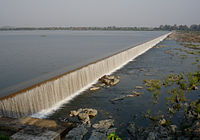
Photo from wikipedia
Abstract In order to provide useful and effective reference indicators for wetland protection and restoration, we are trying to understand the role of hydrological processes in wetlands with hydrological connectivity.… Click to show full abstract
Abstract In order to provide useful and effective reference indicators for wetland protection and restoration, we are trying to understand the role of hydrological processes in wetlands with hydrological connectivity. To quantify hydrological connectivity at soil-profile scale with the soil-profile indexes, dye-tracing field tests were conducted in Yellow River Delta to determine the size and distribution of soil pores, as well as the trail of waterflow. After data analyses, the results showed: (1) where preferential pathways were rich, that is, where hydrological connectivity was strong, the dye coverage was larger (the dye coverage of CLa1 was 0.20 ± 0.08, when CLa2 was 0.22 ± 0.05 and CLa3 was 0.13 ± 0.02), and the dye coverage of preferential pathway was larger (the dye coverage of preferential pathway of CLa1 was 0.16 ± 0.07, when CLa2 was 0.19 ± 0.04 and CLa3 was 0.11 ± 0.02). (2) hydrological connectivity weakens non-linearly from about 30 cm deep. (3) hydrological barrier in soil made dye coverage increase at 10–20 cm deep and it would weaken the vertical hydrological connectivity and strengthen the horizontal hydrological connectivity by preventing the flow from infiltrating further down.
Journal Title: Ecological Indicators
Year Published: 2020
Link to full text (if available)
Share on Social Media: Sign Up to like & get
recommendations!